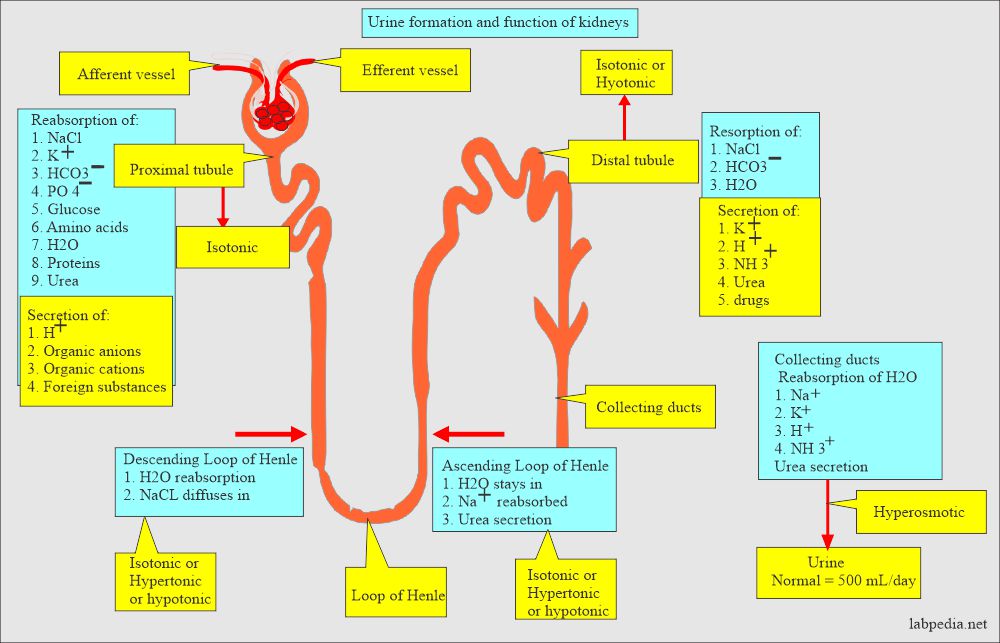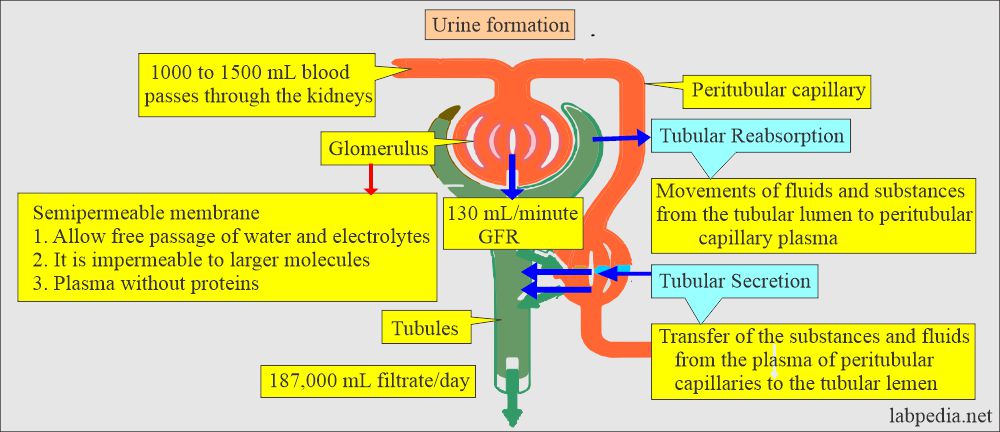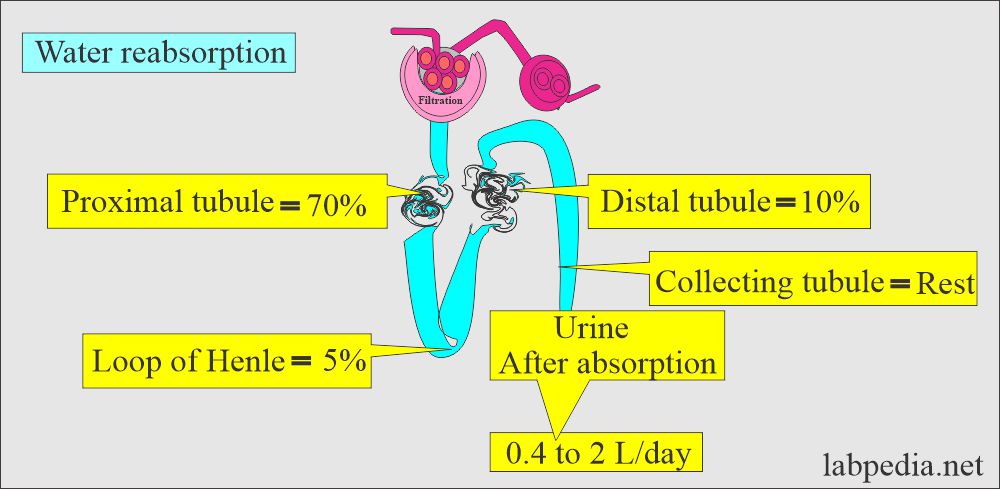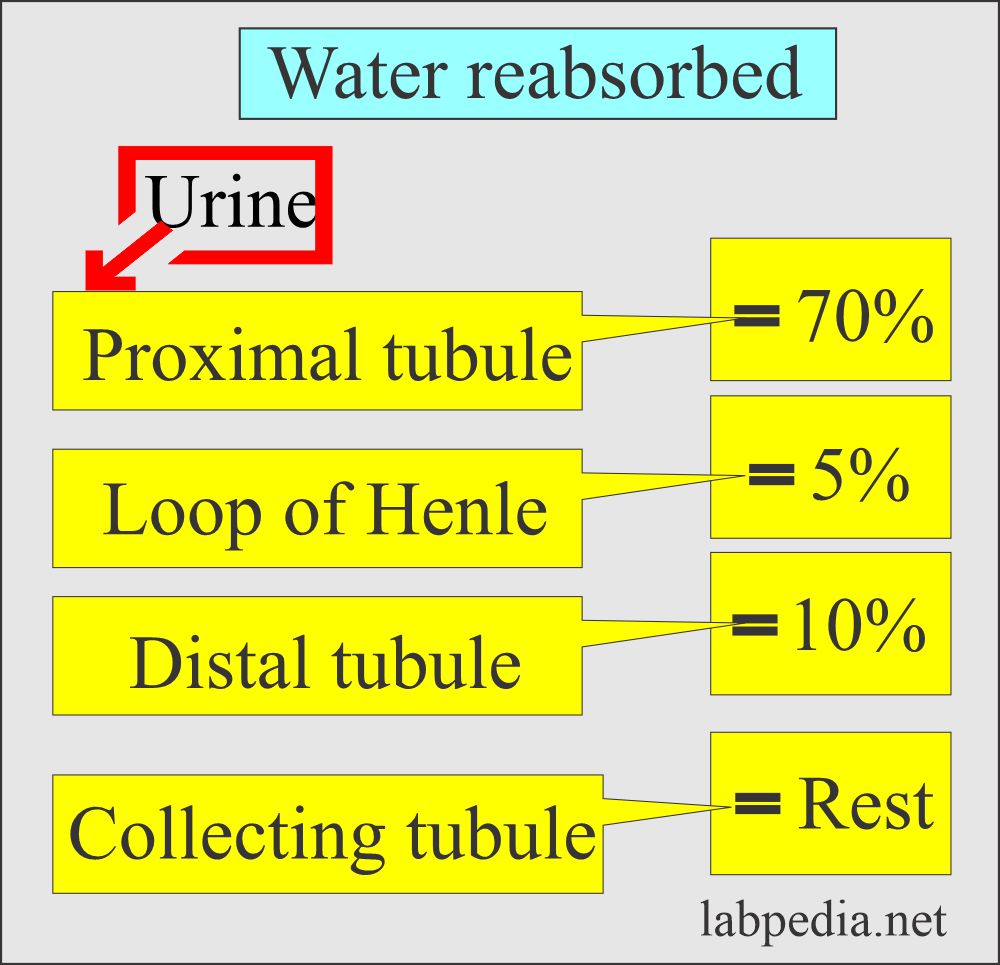Urine Formation, Types of Urine, and Urine Preservatives
Urine formation
Definition of Urine
- kidneys filter large amounts of plasma and reabsorb most of it, which is filtered, and leave behind the unwanted metabolic waste to be eliminated is called urine
- Urine is formed by the kidneys, passes through the ureters, and is stored in the urinary bladder.
- Normal urine specific gravity is around 1.024, and the color is clear.
Urine formation takes place in three steps:
- Ultrafiltrate formation from the glomeruli from the plasma.
- Reabsorption of the water and solutes from the ultrafiltrate.
- Secretion of the extra solutes into the tubular fluid, like urine.
Kidneys function in urine formation:
- Urine formation.
- Protein conservation.
- Regulation of acid-base balance.
- Regulation of fluid and electrolyte balance.
- Hormonal function.
- Removal of potentially toxic material is one of the main functions of the kidneys.
Nephron functions in urine formation are:
- Ultrafiltration is a protein-free plasma filtrate.
- Maintain the body fluid volume.
- Maintain the composition of the electrolytes in balance.
- Maintain the pH.
Urine tubular reabsorption process in urine formation:
- This is the movement of fluids and substances from the tubular lumen to the peritubular capillary plasma.
Tubular Reabsorption:Mode of transport Substances Site of reabsorption - Active transport
- Sodium (Na)
Proximal and distal convoluted tubule - Chloride (Cl–)
Ascending loop of Henle - Glucose, salts, and amino acids
Proximal convoluted tubule - Passive transport
- Urea
Proximal convoluted tubule and ascending loop of Henle - Sodium (Na+)
Ascending loop of Henle - Water (H2O)
Proximal convoluted tubule, descending loop of Henle, and collecting tubules.
Tubular secretion process in urine formation:
- This is the transfer of substances and fluids from the plasma of the peritubular capillaries to the tubular lumen.
Tubular secretion process in urine formation:
| Substances | Site of secretion |
|
|
|
|
|
|
|
|
|
|
|
|
|
|
|
|
Chemical substances and their excretion and absorption in the renal system:
| Chemical substance | After filtration | Reabsorption g/24 hours | Excreted g/24 hours |
| Sodium | 540 | 537 | 3.3 |
| Potassium | 28 | 24 | 3.9 |
| Bicarbonate | 300 | 300 | 0.3 |
| Chloride | 630 | 625 | 5.3 |
| Urea | 53 | 28 | 25 |
| Creatinine | 1.4 | 0.0 | 1.4 |
| Uric acid | 8.5 | 7.7 | 0.8 |
| Glucose | 140 | 140 | 0.0 |
- An average of 115 to 180 L for females and 130 to 200 L of fluids for men were filtered through the glomeruli each day.
- Water 180 L is filtered, 178.2 L is reabsorbed, and only 1.5 L is excreted daily.
- Sodium 25,200 meq/day is filtered, 25050 is reabsorbed, and only 150 meq is excreted daily.
- Potassium 720 meq/day is filtered, 620 is reabsorbed, and only 100 meq is filtered per day.
Summary of urine formation and functions of the kidney:
- The process of absorption needs metabolic energy to do active reabsorption.
- This process is against the gradient, so it needs energy.
- Active reabsorption of glucose, amino acids, low-molecular-weight protein, sodium, calcium, magnesium, potassium, uric acid, chloride, and bicarbonate is regulated by the kidneys according to the level of these substances in the blood and the need of the body.
- Passive reabsorption takes place when substances move by simple diffusion as a result of an electrical or chemical concentration gradient.
- No cellular energy is involved in this process.
Proximal tubule’s role in urine formation:
- Proximal tubular cells perform various physiologic functions for the formation of urine.
- About 80% of salts and water are reabsorbed from the glomerular filtrate in the proximal tubules.
- All glucose and amino acids are reabsorbed.
- The plasma glucose level is completely reabsorbed and does not appear in the urine.
- Higher the plasma concentration of the glucose, the greater the quantity of glucose excreted in the urine.
- Unless it crosses renal thresholds.
- Low-molecular-weight substances are reabsorbed to some extent like:
- Protein.
- Urea.
- Uric acid.
- Chloride, bicarbonate, phosphate.
- K+, Ca++, Mg++.
- Secreted into a tubular fluid by the tubular cells are:
- Organic acids.
- Bases.
- H+ ions.
- Ammonia (NH3).
Tubular Secretion role in urine formation:
- There is the transport of the substances into the tubular lumen.
- This process is opposite to tubular reabsorption.
- This may be an active or passive process.
- Substances that are transported from blood to the tubules and excreted in the urine include potassium (K+), ammonia, uric acid, certain drugs (penicillin), and hydrogen ions (H+).
Loop of Henle role in urine formation:
- Descending loop of Henle is highly permeable to water.
- The loop of Henle is increasingly hypertonic.
- Urine is highly concentrated at the bottom of the loop.
- Ascending limb is relatively impermeable to the passage of the water but actively absorbs sodium (Na+) and chloride (Cl–).
- The ascending limb of the loop of Henle transfer sodium chloride (Na+Cl–) actively from its limen into the interstitial fluid.
- The tubular fluid in the lumen is hypotonic and interstitial fluid becomes hypertonic.
Distal convoluted tubule role in urine formation:
- A small fraction of the filtered sodium (Na+), Chloride (Cl+), and water are reabsorbed in the distal convoluted tubule.
- The distal convoluted tubule responds to ADH (anti-diuretic hormone).
- Distal convoluted tubule permeability for water increases in the presence of ADH. It will be low in case of absent ADH hormone.
- Potassium (K+) is reabsorbed or secreted in the distal tubule.
- Aldosterone stimulates sodium (Na+) reabsorption and potassium (K+) secretion in the distal tubule.
- Hydrogen (H+), ammonia, and uric acid secretion occur in the tubule. At the same time, bicarbonate has reabsorbed in the tubule.
Collecting duct role in urine formation:
- ADH (anti-diuretic hormone) controls the water permeability of collecting tubules in all its length.
- In the presence of ADH, a hypotonic tubular fluid entering the ducts loses water.
- Sodium (Na+) and chloride (Cl+) are reabsorbed in the collecting duct.
- The collecting duct also reabsorbed potassium (K+), ammonia (NH3), and Hydrogen (H+).
- The collecting duct is relatively impermeable to urea.

Urine formation and functions of kidneys
Summary of Urine formation:
| Chemical substances | Quantity filtered/day | Quantity excreted/day | Amount reabsorbed |
| Water | 180 L/day | 1.5 L/day | 99.2% |
| Potassium | 700 meq/day | 50 meq/day | 92.9% |
| Sodium | 24,000 meq/day | 100 meq/day | 99.6% |
| Bicarbonate | 5000 meq/day | 2 meq/day | 99.9% |
| Chloride | 20,000 meq/day | 100 meq/day | 99.5% |
| Albumin | 360 mg/day | 18 mg/day | 95% |
| Glucose | 180 g/day | 0 g/day | 100% |
Urine samples Types:
- Random Sample:
- This is collected without any precaution and may be collected at any time of the day.
- This may be collected for the drug abuse analysis.
- Morning sample:
- This is the first sample when the patient gets up in the morning.
- This is concentrated urine.
- This is the choice of sample for microscopic examination.
- This is also the sample choice for the urine constituents to detect protein, HCG, and other substances.
- 8 hours sample:
- This may be used as an alternative to the first-morning sample because this will also be concentrated in the urine.
- 24-hour sample:
- This sample is used to quantitate any urine solutes like proteins to avoid that substance’s diurnal variation.
- Instruct the patient to void the first sample and note the time. After that, collect all the samples until 24 hours are completed.
- Now void the last sample in the container.
- 24 hours of samples are used for the substances with diurnal variations like catecholamines, 17-hydroxysteroids, and electrolytes.
- Timed Specimen:
- These samples are collected at a predetermined time, like 1,4 or 24 hours.
- For a collection of times, a sample patient is given special instructions for the diet or the use of drugs.
- Clean catch sample:
- In this case, the patient is instructed to clean the genitalia with water and soap.
- Then the midstream sample is collected.
- These are used for the bacteriological culture.
- Caution should be taken that the container should not touch the genitalia.
- Catheter samples:
- These are usually collected from seriously ill patients who are already catheterized.
- Or can insert the catheter into the urinary bladder to collect the sample.
- These are used for the microbiological examination of critically ill patients.
- Suprapubic sample:
- The sample is directly collected from the urinary bladder with a suprapubic needle inserted into the urinary bladder with complete sterilization.
- This sample is ideal for the culture, and there is a bypass of the urethra.
- This will be a good sample of the culture from the urinary bladder.
- This is usually done from the distended urinary bladder.
- Urine from children:
- Collecting the sample from infants is difficult.
- There are adhesive bags available to put on the urethra to collect urine.
Various Urine samples and their indications:
| Type of urine sample | Indications |
|
|
|
|
|
|
|
|
|
|
|
|
|
|
|
|
|
|
|
|
Urine preservation and type of preservatives:
Role of urine preservatives:
- These preservatives are added to the following:
- Reduce bacterial growth.
- Decrease the decomposition of the chemicals.
- Keep the substance in solute form.
- Decreases the atmospheric oxidation of unstable compounds.
- Refrigeration is the most useful for the collection and its utility increases with the preservatives.
- There are tablets commercially available are:
- Potassium acid phosphate.
- Sodium benzoate.
- Benzoic acid.
- Methenamine.
- Sodium bicarbonate.
- Red mercuric acid.
Advantages and disadvantages of preservatives:
- These tablets act mainly by lowering the pH of urine and releasing formaldehyde.
- Formalin is used as the preservative, but it will precipitate urea and inhibit some chemical reactions when it is in a large amount.
- Acidification of the urine below pH 3 is widely recommended. This is widely used to preserve urine for 24 hours and is particularly useful for calcium, steroids, and vanillylmandelic acid determination. HCL 10 mL, 6 mol/L per 24 hours of urine is used.
- Sulfamic acid is used at 10 g/L to reduce the pH.
- Boric acid is used at 5 mg/30 mL, but it causes precipitation of the urates.
- Toluene is only an organic preservative and is still used; this will not prevent anaerobic microorganisms’ growth.
- Sodium carbonate is used at 5 g/for 24 hours urine sample to preserve the porphyrins and urobilinogen.
Various urine preservatives are:
Refrigeration:
- When there is a delay in examining urine, refrigerate at 2 C to 8 C.
- Urine can be freezed at -24 C to -16 C.
- If there is a delay of more than 2 hours of urine collection for the examination, it needs preservatives.
- When urine is refrigerated, then:
- This will not interfere with the urine chemical tests.
- It prevents bacterial growth.
- The disadvantage is there is an increase in the specific gravity.
- Precipitate amorphous phosphates and urates.
- Refrigerate for albumin, aldosterone, amylase, chloride, cortisol, estradiol, FSH, lipase, oxalate, protein, uric acid.
HCl (Hydrochloric acid):
- Add 6 mL of hydrochloric acid (HCL) for Aldosterone, calcium, creatinine, cystine, homovanillic acid, 17-ketosteroids, oxalate, and VMA.
Boric acid:
- It will preserve protein.
- Preserves formed elements.
- It will not interfere with the routine examination except for the pH.
- This is bacteriostatic.
- It interferes with drugs and hormones.
- The disadvantage is that it may precipitate crystals when used in large amounts.
- Add boric acid for albumin, cortisol, estrogen, aldosterone, amino acid, chloride, HCG, citrate, cortisol, creatine, DHEA, FSH, glucose, phosphate, 17- Ketosteroids, protein, uric acid, and zinc.
Formalin (formaldehyde):
- It is the best for urine sediments.
- It acts as a reducing agent.
- It interferes with chemical tests like glucose, esterase, blood, and white blood cells.
- Rinse the container with formalin to preserve the cells and casts.
Sodium fluoride:
- It prevents glycolysis.
- This is a good preservative for the analysis of the drug.
- It will interfere with test strips for glucose, white blood cells, and red blood cells.
Phenol:
- It does not interfere with routine tests.
- It changes the odor.
- Use one drop of phenol per ounce of urine.
Toluene:
- It does not interfere with routine tests.
- The disadvantages are that it floats over the surface of the urine and may block the pipette.
Thymol:
- It is an excellent preservative for glucose and sediments.
- It interferes with acid precipitation for the protein.
Commercial preservative tablets:
- It is easy to use when refrigeration is not available.
- Check the composition of the tablets to find out any effect on the test.
- These tablets contain the above preservatives and sodium fluoride.
Various urine preservatives are:
| Samples | Preservative |
|
|
|
|
|
|
|
|
|
|
|
|
|
|
|
|
|
|
|
|
|
|
|
|
|
|
|
|
|
|
|
|
|
|
|
|
|
|
|
|
|
|
|
|
|
|
|
|
|
|
|
|
|
|
Questions and answers:
Question 1: What is the role of sodium fluoride?
Question 2: What is the purpose of thymol preservative of urine?




Prepare it for pdf form,for easly downloading
Please this website labpedia.net is always present on internet.